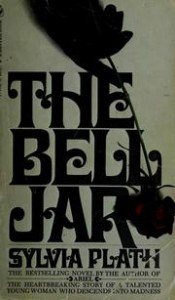There are many covers around the world that distinctly represent their respective novels. The novel, “The Bell Jar” by Sylvia Plath had several covers since it was first published. At the time, Sylvia also went by the name Victoria Lucas. There are two specific covers that stand out to me the most. The first, is the cover published by Bantam Press on April 1972. The other cover is the novel’s newest 50th anniversary edition by Faber and Faber published in 2013. Both novel covers portray their own messages which relate back to the story and the main character Esther.
The first novel cover was published by Bantam Press on April 1972. It is a dying rose, or based on the novel, a lifeless rose. I chose this because it lacks a connection from the title of the book and also represents a feminine essence. In the novel, Cee hands Esther a paper rose from the hat she was wearing. “When they asked me what I wanted to be I said I didn’t know. “Oh, sure you know,” the photographer said. “She wants,” said Jay Cee wittily, “to be everything. I said I wanted to be a poet. Then they scouted about for something for me to hold. Jay Cee suggested a book of poems, but the photographer said no, that was too obvious. It should be something that showed what inspired the poems.” (Plath, Chapter 9) In the novel, Esther, was on the verge of tears when her picture was about to be taken. In the previous chapter she had even tried hurting herself during her trip with her boyfriend. I believe the rose represents something very meloncholy. The rose in the novel and the cover depicts that moment of sadness and also represents Esther’s lack of inhibition when she was asked what she wanted to be which is constantly mentioned throughout the story. In the bottom of the cover it says, “The Heartbreaking Story of a Talented Young Woman Who Descends Into Madness.” This is what the entire novel is typically about, a character with a promising future who who dwindles into insanity.
In the cover of the novel by Bantam, the rose is held by a dark hand. The hand is holding the dead rose down towards the bottom. This can be interpreted as a certain darkness that holds her in her life. Esther is symbolized as the dying rose. The dark hand which is holding her is pointing her downwards like the direction which her life is going over the duration of the novel. Like the rose which looks hurt and abused, I assume Esther is hurt mentally from her attempts at meaningful relationships. Through society expecting her to lose her virginity after a healthy marriage, she seeks to take her future into her own hands by embarking on a sexually experimenting journey. After a turn of events, she is unable to seek out her desires as the man she pursues does not pursue her back. Slowly, a madness is descending upon her. After Ester’s first shock treatment, she was unable to recognize the woman in the reflection of an elevator she was in, even though the woman was her. She perceived the lady in the reflection as another woman in the room. Esther, very much like the rose on the cover of the novel is abused, and held downwards towards her end as several of her suicide attempts cause her to be locked into a mental illness hospital. She could not even recognize her bruised and discolored face in the mirror, and could not tell if the “creature” she saw in the reflection was a man or woman. She is neglectful towards her mother as Esther does not see the damage she is causing her, which is a symptom of her mental illness. The dark hand which is holding Esther, the rose, symbolizes this mental illness which slowly consumes her throughout her journey.
The second cover I chose is the 2013 version by Faber and Faber that caused a lot of controversy for the novel’s 50th anniversary edition. It misintereprets the true meaning of the book by displaying a very bright cover with a woman holding a compact case to her face. The aspect of the novel that this cover supposedly relates to is the beginning when Esther starts working as an intern for the woman’s magazine company over the summer and it also represents the 1950’s, the time in which this story took place. The cover is ultra feminine, I suppose to represent her working along other women throughout the summer. “So there were twelve of us at the hotel, in the same wing on the same floor in single rooms, one after the other, and it reminded me of my dormitory at college. It wasn’t a proper hotel — I mean a hotel where there are both men and women mixed about here and there on the same floor.” It is a very girly cover, perhaps trying to convey to the readers that this is about a woman, a woman with style. The scene where this part of the cover is mentioned is when Esther discusses all her gifts. “I still have the make-up kit they gave me, fitted out for a person with brown eyes and brown hair: an oblong of brown mascara with a tiny brush, and a round basin of blue eyeshadow just big enough to dab the tip of your finger in, and three lipsticks ranging from red to pink, all cased in the same little gilt box with a mirror on one side. I also have a white plastic sunglasses case with colored shells and sequins and a green plastic starfish sewed onto it. I realized we kept piling up these presents because it was as good as free advertising for the firms involved, but I couldn’t be cynical. I got such a kick out of all those free gifts showering on to us.” (Path, Chapter 1)
Another way one could interpret this cover is by assuming that the woman adjusting her make up has two faces. She has a face she adjusts for the whole world to see. A face and image that is very different from how she is feeling within. This is the case with Esther through the beginning and middle of the story. She keeps up a facade and her thoughts are different from her behavior. I believe this cover is very misleading because it doesn’t effectively represent what the book is about thus all the controversy over it. According to many websites and blogs, people may get the misconception that this is a chick lit, not about a woman with depression because of the bright red coloring. The cover isn’t very creative and lacks depth compared to all the other ones. Another thing I noticed is that in the 50th anniversary cover, the woman has her eyes closed as she is applying make-up from an empty make-up pallet. She also seems to have a very mild frown on her face. This part of the cover image can be interpreted as how her life throughout the beginning of the novel was depressing for her. In this part of The Bell Jar, she is not content with the lifestyle she is living as she compares herself to the other women living in the hotel with her. She sees herself in the mirror and does not feel that she wants to be the woman that everyone else wants her to be. Perhaps the empty make-up pallet resembles how she is done with putting on a cover and is ready to act in the way she feels she should, not what society “makes-up” for her.
After analyzing these two covers I learned that covers given to a novel are not always easily comparable to what their meanings are or how they portray towards the novel itself. “The Bell Jar” is a novel about the journey of a young woman who sees the flaws of society in her time, who behaved unconventionally as her “dark passenger” started to take the wheel. The covers given to this book by both The Bantam Press and Faber and Faber, each had their own hidden messages. For the Bantam Press, the cover was a depiction of Esther herself as a rose who was once very much alive during her childhood, but in time, after being held by darkness, slowly shriveled away into a deathly state. As for the Faber and Faber cover, Ester is a modern-like girl who sees her reflection and does not seem to approve of what it looks like.






